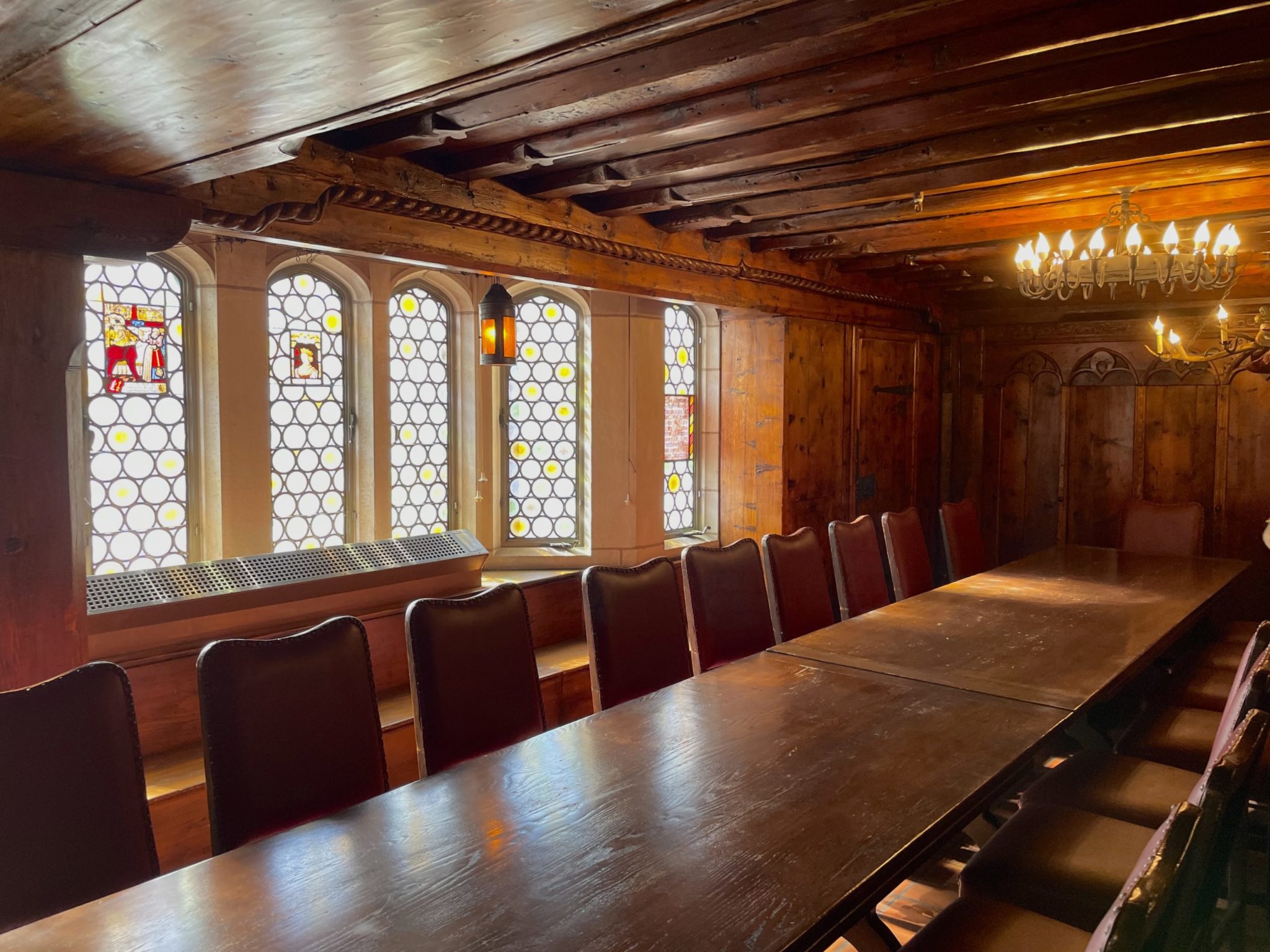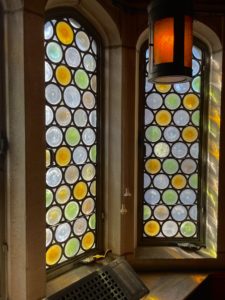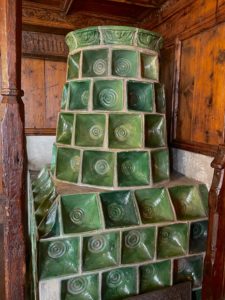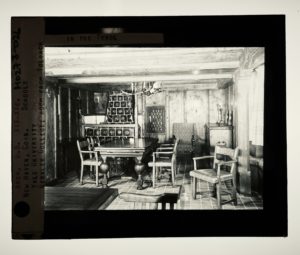
Iris Tsouris
It was a small, opulent room, guarded by a heavy, medieval door on the second floor of Berkeley College, entryway C. Its mahogany ceiling was low, about eight feet. The light, flooding in from the south side of Elm Street, was warped by stained glass and colored cornflower blue.

Geographically, if Yale University were a person, then Berkeley would be its lungs, and the Swiss Room its heart. I first learned about the Swiss Room from a collection of lantern slides in the Manuscripts and Archives reading room. I gathered that it was a bizarre-looking place, with two varnished tables of unequal lengths and an assortment of red dining chairs. Suspended from its ceiling are three German “Leuchterweibchen”–chandeliers made of antlers, with tiny, smiling women carved into their base. A green Alpine stove, fashioned from glazed clay, appeared to inhabit its left corner. The furniture itself looked ancient, arranged to reproduce the look of a 16th-century sitting room. A soft, doe-eyed portrait of Mary of Burgundy adorned one of the stained glass windows.
For a long time, I was very fond of the Swiss Room, perhaps especially because it was available exclusively to Berkeley fellows and stripped of any known, widespread existence. The room, secluded and mysterious, began to occupy a significant portion of my daydreaming life. I would imagine how its secret cohort would fill such a space, shelling snow peas, plaiting each other’s hair, strumming quiet melodies on guitar. I thought the room held something that, for an ordinary person like myself, was just out of reach; the charms of both a grand, processional hall and a small, intimate cottage. I longed to access it.
When the clock struck noon, I walked through the Berkeley common room, past the bloated, taxidermied elk heads, to where Annette was standing. Annette was a tall, wiry woman who worked in the dining hall. She had auburn hair, kohl-lined eyes, and spoke to me with such earnestness that I felt we shared a similar, urgent sense of curiosity. I was writing an art history paper, I told her. I wanted to see the Swiss Room.
Annette understood and retrieved the dining hall manager, who, after some time, reached for the ring of keys in her back pocket.
I entered the Swiss Room for the first time. It was lifeless, with none of the sweetness and joy of my daydreams. Annette patted the ceramic Alpine stove, which had seemed so pockmarked and beautiful in my lantern slides. It now looked terribly obsolete. The Leuchterweibchen above us winked sadly. The lanterns embedded in the walls shone with fluorescent electricity.

The place, I felt, had been depleted of any chance to develop a history beyond a perverse, aristocratic origin. It is true that the entirety of Yale, its colleges and lecture halls, were built for the elite; yet these spaces, with their gradually-growing accessibility, feel as though they have evolved to accommodate people of all classes and histories. The Swiss Room, on the contrary, remains frozen in time.

I would have liked to see it now, ablaze and impassioned, burning away its life with hurried, feverish fervor. Who dined there now? Who possessed it? Very few people. It was a somber, lonely space — complete and utter fiction.
“Restrict the use of the Swiss Room to small, faculty-sponsored events and enforce a no-smoking policy,” wrote Judith Francis Kennedy, a proponent of saving the room from decay and varnish leaks, ostensibly brought by the barbarous undergraduates who once frequented it. “It should be stressed that these recommendations are not the only possible solutions. However, lack of any action will lead to a predictable path of entropy and the eventual demolition of the Swiss Room.”
**
When I was younger, I would run through my neighborhood to play in an abandoned homestead, yellowed by time and tucked away at the edge of a forest on Briarlake Road in Atlanta, just fifteen minutes from where I lived. Like the Swiss Room, its existence was unique and precarious, threatened by the lightest human touch. This did not deter me. I remember leaping onto its porch and clinging dearly to its pillars. Sometimes, I would venture inside, stepping tentatively on dulled, wooden planks.
It was in Briarlake Forest where I came to know my father as a warm, unbothered person. He lived and worked in an entirely different state, nearly four hours away. Yet every Friday, he would return, and we would walk together to the homestead. I remember clutching his leg and tugging at the course, silver hairs on his beard. My father would laugh at this, touch my mother’s cheek, and kiss the crown of my head. We would sit on the homestead’s staircase and eat sliced tomatoes on hunks of bread and cheese. The world moved with our footsteps.
A few months after my high school graduation, our city council convened and voted to demolish the homestead. Too many had roamed its fraying, wooden floors, they told us. It had since rotted through.
**
I contemplated all of this as I walked back from Berkeley — the Swiss Room and the Briarlake homestead, each holding on to their last, shuddering breaths. One dead, the other dying. It was during this time that it began to rain. I stood under my umbrella, at the corner of York and Elm Street and observed Yale’s happenings — the crosswalks and people, the great, impersonal architecture, the grandiose, gothic air. I thought about its inward-facing courtyards and expansive, subjugating tendencies. Yale will march on, I had been told, ousting residential communities and eating away at its city, all while the rare and precious Swiss Room, its geographic heart, collects dust and embodies a terrible, persisting state of neglect. I wondered what hid, within those cold and ashen walls, that was so worth protecting.
I felt very sad, then. I would have much preferred to watch the room die.







